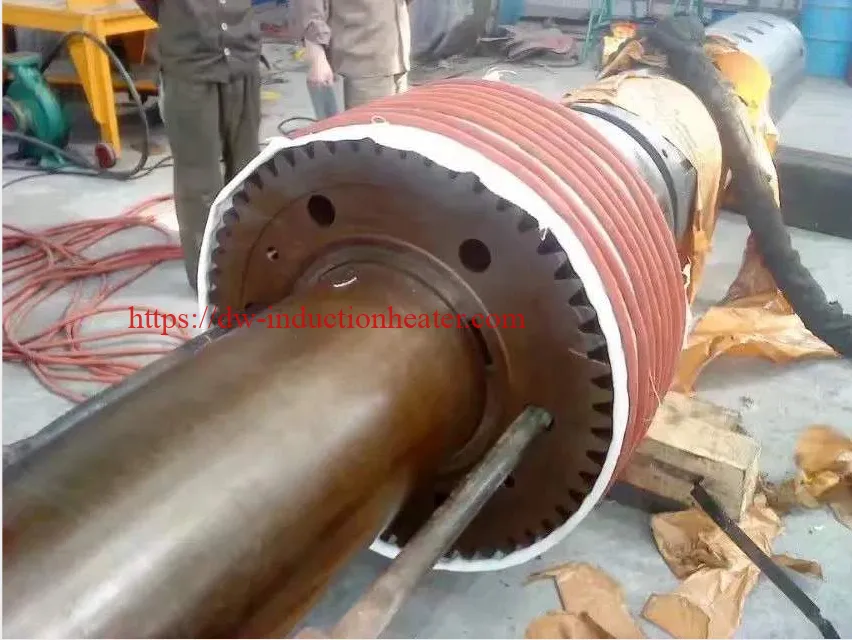The assembly of large gears onto shafts is a crucial process in the manufacturing of heavy machinery. This operation demands precision, speed, and reliability to ensure the proper functioning and longevity of the machinery. Traditional methods, such as press fitting or heating with gas flames, were often time-consuming and inconsistent in temperature control. The adoption of induction heating assembly offers a more efficient and precise solution to meet modern manufacturing needs.
Induction heating involves generating heat through electromagnetic induction within the gear or shaft, enabling precise temperature control and energy-efficient heating without direct contact or flame. This process has revolutionized gear assembly, especially for large-diameter gears like 800mm, which require uniform heating and strict tolerances.
Process Overview
- Preparation of Workpieces:
- The gear with an 800mm diameter and corresponding shaft are cleaned and inspected for surface finish, tolerance, and dimensional accuracy.
- Assembly tolerances for interference fit and compatibility are checked (e.g., shaft diameter slightly oversized for a tight fit upon cooling).
- Configuration of Induction Heating System:
- The induction heating coil is designed to match the gear’s profile, ensuring uniform heating along the gear’s circumference.
- Key parameters such as heating frequency, speed, and temperature control are programmed, ensuring precise operation.
- Heating the Gear:
- The induction machine applies heat to expand the gear. The heating process parameters ensure the target temperature (typically 200–300°C) is reached uniformly.
- Temperature sensors and thermographic cameras monitor real-time heat distribution.
- Mounting:
- Once heated, the expanded gear is quickly mounted onto the shaft using hydraulic or mechanical lifting tools within the specified time window.
- The gear cools and contracts on the shaft, creating a strong interference fit.
- Post-Assembly Inspection:
- The assembly is inspected for tolerances, alignment, and any residual stresses using ultrasonic and alignment checking equipment.
Technical Parameters of the Induction Assembly Process
| Parameter | Value/Details |
|---|---|
| Gear Diameter | 800mm |
| Gear Material | High-strength alloy steel |
| Shaft Material | Carbon steel |
| Heating Temperature Range | 200–300°C |
| Heating Speed | 1–2 seconds per 10°C increase |
| Energy Consumption Per Gear | ~10–12 kWh |
| Induction Frequency | 10–50 kHz |
| Heating Coil Design | Custom multi-turn copper winding |
| Cooling Time | 15–20 minutes (air cooling or assisted fan) |
| Alignment Tolerance Post-Assembly | ±0.01mm |
Data Analysis
- Energy Efficiency:
- Comparative analysis indicated a 30% reduction in energy consumption compared to traditional flame heating.
- Precise heating reduced energy waste, with consumption averaging 11kWh per gear.
- Heating Uniformity:
- Thermographic sensors showed temperature variation within ±2°C across the gear’s surface.
- Assembly Time:
- The heating and mounting process took less than 6 minutes per gear, significantly reducing downtime in the assembly line.
- Traditional methods (e.g., press with external heating) took over 20 minutes.
- Material Performance Analysis:
- Post-assembly fatigue tests revealed no microcracks or structural deformity owing to consistent heating and time-controlled cooling.
- Cost Savings:
- Reduced labor time, energy efficiency, and minimal scrap material saved an estimated 25% per assembly operation.
Influencing Factors
Several key factors influenced the effectiveness of this induction heating process:
- Material Properties: Different thermal expansion rates of shaft and gear materials were analyzed to optimize the interference fit.
- Heating Temperature: Improper temperature could result in gaps (underheating) or strain (overheating), necessitating precise calibration.
- Cooling Time: Sufficient cooling time ensured the gear contracted uniformly without inducing internal stresses.
- Coil Design: The custom-built coil played a vital role in ensuring uniform heating along the 800mm circumference.
Advantages of Induction Heating for Gear-Shaft Assembly
- Speed and Efficiency:
- Faster assembly compared to traditional methods, significantly reducing production time.
- Energy Savings:
- Enhanced energy efficiency and operational cost-saving through targeted heat delivery.
- Precision and Consistency:
- Improved accuracy in heating uniformity ensured dimensional tolerances were maintained.
- Safety and Environmental Benefits:

- No open flames reduced the risk of fire hazards and improved workplace safety.
- No emissions of harmful gases made it an eco-friendly solution.
Conclusion
Using induction assembly heating for the gear-shaft assembly process in heavy machinery has proven to be efficient, precise, and cost-effective. The application for a large-diameter gear (800mm) demonstrated significant improvements in energy efficiency, assembly speed, and product reliability. Given the accuracy and repeatability of this method, it is highly recommended for adoption into industrial manufacturing workflows for heavy machinery.
Recommendations
- Adopt induction heating for large gear assembly to minimize cycle times and enhance energy efficiency.
- Regularly calibrate and maintain the temperature control systems and heating coils.
- Expand the process to other applications in heavy machinery requiring precise thermal expansion fits.
- Incorporate advanced sensors for real-time monitoring and predictive maintenance of equipment.

